Repower or Build a New Combined Cycle Unit?
URS recently performed a combined cycle repowering study to determine the feasibility and economics of repowering an existing steam turbine that went into service in the 1950s. The competing option was building a new combined cycle unit. The results of the study provide insight for others considering the same alternatives.
URS recently completed an engineering study for a Midwestern utility with the goal of identifying the most cost-effective gas-fired plant that could be feasibly added to its electricity supply system. Two design alternatives were identified: repowering a 1950s-vintage steam turbine that was originally built as part of a coal-fired plant or building a 2 x 1 combined cycle plant based on two different F-Class combustion turbines (CTs). The new build would have to produce a minimum 560 MW net. The levelized cost of electricity from the repowered and new plant options was compared and the best option was identified.
Repowering Options
Repowering entails removing and replacing the steam generation portion of an existing power plant with CTs and heat recovery steam generators (HRSGs). The steam produced by the new, high-efficiency gas-fired equipment is sent to the existing steam turbine to produce electricity. The advantage, beyond the obvious construction cost savings, is that the existing steam turbine (ST) and its auxiliary systems are operational, and there is a generator electrical connection. The existing ST in this case was a 180-MW-class, 1,800-psig unit with 1,050F main steam and 1,000F reheat steam.
Site-specific factors often restrict the number of design options, and this project was no different. For example, the land area available for repowering at this site is very constrained and could accommodate only a single combustion turbine. A single Siemens SGT6-8000H was selected for this evaluation because of its proven design and high performance, although the Mitsubishi M501GAC and GE 7FA 7-Series should be seriously considered during preliminary design, should the repowering option be selected. Also, the existing steam turbine condenser uses once-through cooling. However, new thermal discharge limits would limit its reuse, so the repowered project must also convert the existing once-through cooling system to a closed-loop cooling system (cooling tower).
Reuse the Existing Steam Turbine. One major design challenge when repowering an existing plant is to match the steam production capability of the CT and HRSG with the steam needs of the existing steam turbine. In this project, the repowering option requires modifications to the existing steam turbine, such as blanking off all the existing feedwater heater extractions and introducing a low-pressure (LP) admission at the crossover point. Otherwise, the steam paths (essentially the rotating and stationary parts that steam contacts as it passes through the ST) remain unchanged. The steam supply modifications are required because the repowered ST is generally not able to pass the original design high-pressure (HP) steam flow through the entire turbine because the extraction ports are closed. The net effect is a large increase in LP steam flow that must be accommodated in the steam cycle design.
The unit may or may not be able to reach its rated electrical output, depending on which steam cycle parameter limits its output. These factors can be maximum allowable reheat pressure, steam pressure at the crossover, maximum allowable last-stage bucket (LSB) flow, or the generator rating.
Floating throttle pressure will be lower than the design value because of the reduced throttle flow, and it will typically be lower than the optimum value for combined cycle operation. This low throttle pressure can be corrected by replacing the steam path in the HP turbine. The intermediate-pressure (IP) steam path is on the same rotor shaft, so it can be replaced with minimal additional cost when replacing the HP steam path. Because turbine modifications are usually required to maintain the correct axial thrust balance and the original steam paths may be suffering degradation from age, replacing the steam paths is often cost-effective.
Condenser modifications will generally be required to provide oxygen removal from the condensate. Adding trays below the tubes and relocating the makeup header to the top of the condenser shell will generally provide an acceptable oxygen level of 7 ppb.
Duct Fire HRSGs. The HRSG was designed with duct firing to maximize the steam cycle output. In many repowering designs the limiting factor for steam cycle output is the flow capacity of the LSBs; steam flow through the LSBs increases from the original design when the LP turbine steam extraction points are eliminated. However, this unit had ample LSB capacity, so duct firing was set at a level where the crossover pressure matches that of the original steam turbine heat balance. Maintaining constant pressure at the crossover requires the crossover steam flow rate to remain close to the value set as part of the original unit heat balance.
Table 1 compares steam cycle performance for the repowered configuration with the original fossil unit parameters. Repowered operation is based on annual average ambient conditions with the combustion turbine at full load. Operating points are shown for the unfired HRSG, which provides the best efficiency, and for the maximum-fired condition to produce maximum output. HP and reheat pressures are considerably lower than those of the original steam turbine heat balance. The maximum LSB flow has increased by 10% but is still within the load limit of the LSBs. Hotwell flow has decreased relative to the original heat balance due to eliminating the feedwater heater drains that used to flow into the condenser, allowing reuse of the condensate pumps without modification.
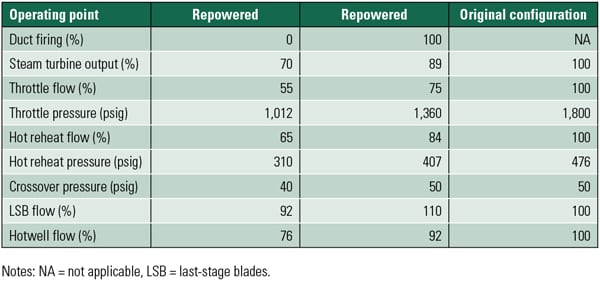 |
| Table 1. Estimated steam cycle performance of the repowered plant using the existing steam turbine. The repowered plant performance is based on the Siemens SGT6-8000H using average annual ambient conditions. No modifications to original steam turbine steam paths were made other than closing off of extraction ports. Source: URS Corp. |
Make Steam Path Upgrades. One disadvantage of the repowered configuration is that it employs the original steam turbine and condenser, which may have an adverse effect on plant reliability. Analysis of North American Electric Reliability Corp. data on plant reliability suggests that an equivalent forced outage rate (EFOR) of 4.0% should be expected for the repowered configuration and 3.6% for the new combined cycle plant option. Replacement of the HP/IP steam paths for the repowered option should move the EFOR close to that of a new installation.
The drop in HP and reheat steam pressures results in a loss of combined cycle efficiency, which can be remedied by replacing the HP and IP steam paths with modern technology. Several suppliers are able to provide new steam paths that will fit within the original outer casings. Also, the replacement steam paths can be specified to keep HP and reheat steam pressures near their optimum values. An additional benefit is that the new nozzles and blades are designed with the benefit of modern computational fluid dynamics technology and have expansion efficiencies substantially higher than those of units designed 60 years ago.
Table 2 shows the expected performance for the repowered configuration with new HP/IP turbine steam paths. LSB flow is 14% higher than that of the original fossil heat balance but still within design limits. Table 3 shows overall performance for the two repowering options. This shows that the upgraded HP/IP turbine steam paths improve output by about 13 MW and reduce heat rate about 1%.
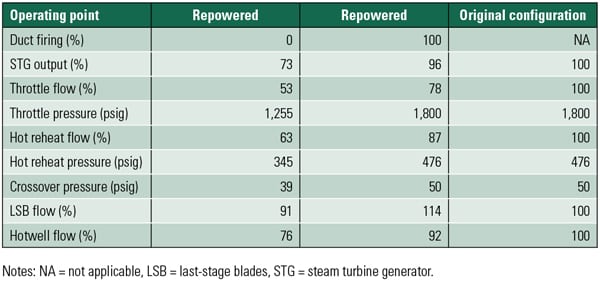 |
| Table 2. Estimated steam cycle performance of the repowered plant using the existing steam turbine with upgraded HP/IP steam paths. Source: URS Corp. |
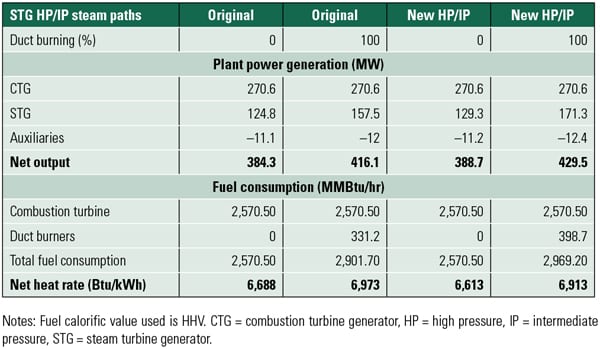 |
| Table 3. Estimated overall performance for the repowered 1 x 1 combined cycles. Repowered performance is based on the Siemens SGT6-8000H combustion turbine generator, with the effect of duct burner use and steam path upgrades shown. Source: URS Corp. |
As explained above, the crossover pressure limit restricted the maximum duct-firing rate. One means of increasing output that was evaluated by this analysis was to bypass a fraction of the condensate around the LP economizer directly to the LP drum. This reduced the amount of LP steam admission and hence allowed greater duct firing, more HP steam flow, and increased output without exceeding the crossover pressure limit, but with an increase in heat loss to the stack and a heat rate penalty (Figure 1).
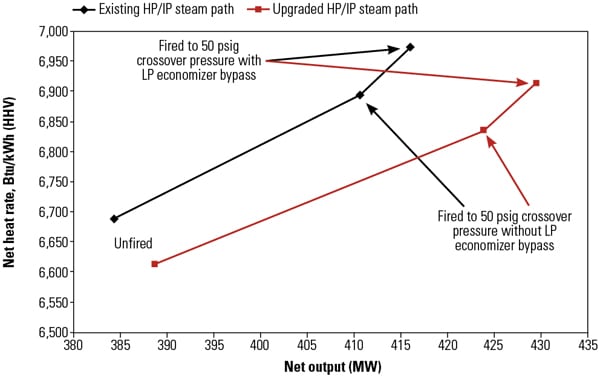 |
| 1. Heat rate of the repowered plant configuration alternatives. Repowered performance is based on the Siemens SGT6-8000H combustion turbine operating at full load at the average annual ambient temperature with variable duct firing. URS Corp. |
New Combined Cycle Options
There is sufficient space at a corner of the plant property for a new 2 x 1 F-Class combined cycle. Conceptual designs were developed based on the GE 7FA 3-Series and 7FA 5-Series combustion turbines. Alstom, Mitsubishi, and Siemens also offer suitable units that should be considered if the new plant option is pursued. The minimum net output of the new plant options was 560 MW, at the average annual ambient temperature.
The overall performance of these two plants is summarized in Table 4. The GE 7FA 3-Series based plant is able to achieve the 560 MW minimum net rating with a small amount of duct firing, while the 7FA 5-Series plant exceeds the standard without duct firing. The heat rate of the new plant is slightly higher than that of the repowered options because the 2 x 1 plants are based on current F-Class technology rather than the H-Class unit used as a basis for the repowered unit. However, the 2 x 1 plants offer substantially higher power output and the 2 x 1 configurations allow greater turndown range for part-load operation.
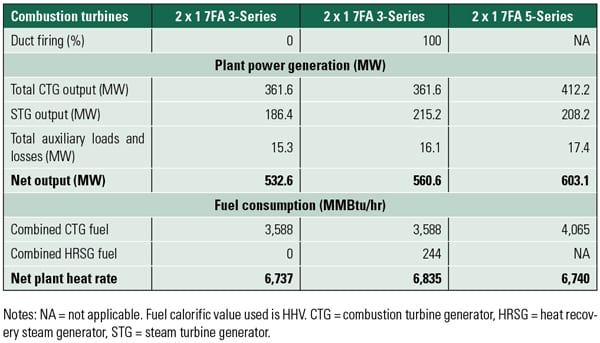 |
| Table 4. Estimated performance of a new 2 x 1 combined cycle. Note that the 7FA 3-Series option requires a slight amount of duct firing to achieve the minimum plant net output of 560 MW, while the 7FA.05-based plant does not. Source: URS Corp. |
The plant based on the new 7FA 5-Series provides about 70 MW more output at essentially the same unfired heat rate as the 7FA 3-Series. Therefore, the 7FA 5-Series was selected as the basis for developing the capital and operating cost estimates.
Capital Cost Estimates
URS prepared total plant cost (TPC) estimates for three options. A TPC estimate includes equipment costs, labor costs, indirect construction costs, engineering, startup and testing costs, and contingencies. It excludes taxes, interest during construction, costs to obtain permits, and owner’s engineer cost. The TPC estimates were based on first quarter 2013 dollars.
- Repower existing steam turbine unit: $407 million or $979/kW, based on 416.1 MW annual average power rating.
- Repower existing steam turbine unit and upgrade HP/IP steam paths: $414 million or $965/kW, based on 429.5 MW annual average power rating.
- New 2 x 1 7FA.05 combined cycle: $678 million or $1,124/kW, based on 603 MW annual average power rating.
It is interesting to observe that the cost of the steam paths upgrade increases TPC by $7 million for the repowered option but reduces the plant installed cost per kilowatt. The repowering with steam path upgrades option also improved the plant heat rate and extends the life of the steam turbine.
The cost per kilowatt for the new combined cycle plant is about 15% higher than for the repowered option. This cost penalty will be offset to some extent by reduced maintenance on the new steam turbine and new condenser and a slightly lower heat rate.
Cost of Electricity Estimates
The cost of electricity was estimated for each of the three options over an assumed 30-year plant life. Operation and maintenance costs were derived from a URS database for similar plants, and life-cycle fuel cost was estimated using the Department of Energy Annual Energy Outlook forecast of natural gas prices. An annual capacity factor of 50% was assumed for each analysis.
The results of the case study show that repowering of the existing steam unit provided better life-cycle economics than construction of a new combined cycle plant. Table 5 shows the cost components that form the levelized cost of electricity (LCOE) estimate. The repowered options show a LCOE advantage of about 5% relative to the new combined cycle. The benefits of lower construction cost and the higher efficiency of the H-Class combustion turbine technology for the repowered unit outweigh the lower efficiency of the existing steam turbine.
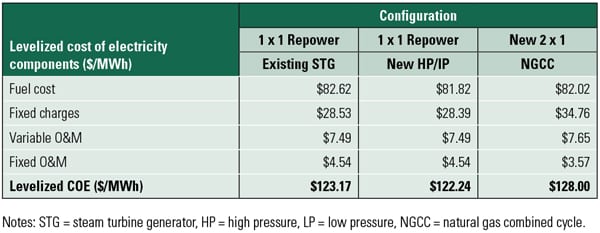 |
| Table 5. Levelized cost of electricity analysis. The analysis is based on a 30-year plant life and operation at an average annual 50% capacity factor. The repower option with upgraded steam path was found to have a 5% cost of electricity advantage. Source: URS Corp. |
Many site-specific constraints and design and construction decisions made in the course of the study led to this conclusion. A key finding was that the investment in upgrading the existing turbine’s HP/IP steam paths with modern technology is a good investment. Your site-specific factors may lead you to a different conclusion, even for a similar plant.
—R.B. Boulay, PE, and M.S. Massoudi, PE, PhD, URS Corp., Energy & Construction Division.